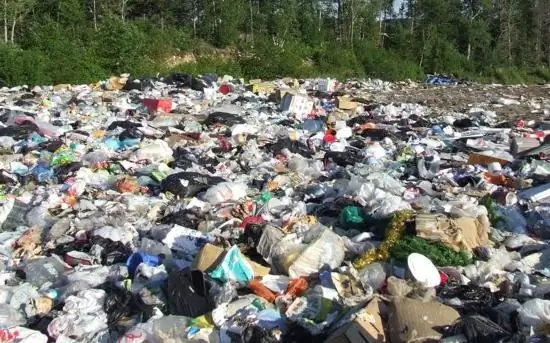2026 Author: Howard Calhoun | [email protected]. Last modified: 2025-01-24 13:10:43
In the course of the activities of medical institutions and other institutions of a similar nature, a huge amount of waste, used materials and substances appear. They carry a potential hazard to human he alth upon possible contact, so the issue of disposal and disposal is quite acute.
Classification of medical waste. Groups A and B
Depending on the degree of danger inherent in the substance, the following groups are distinguished. The first group is class A waste. They are also called non-hazardous to humans. This includes garbage from administrative premises, materials that did not have direct contact with patients (there are no biological fluids on them), food residues (except for infectious diseases, venereal departments), furniture, tools and devices for diagnostics. The second group is class B waste. They are considered hazardous. This category includes all substances that have come into contact with the blood or other secretions of a sick person, food debris and other materials from infectious diseases departments. If the laboratory is handlingmicroorganisms of the 3rd or 4th pathogenicity group, then its waste also belongs to this category. Class B medical waste includes biological materials from surgical interventions.

Waste class C, D, D
Especially hazardous waste belongs to group B. This includes those materials that were used when working with people suffering from dangerous infections (including anaerobic). In addition, the sources of this type of waste are laboratories that conduct research on microorganisms of 1-4 degrees of pathogenicity. Class D consists of those elements that pose a certain toxic hazard. These can be drugs with an expired shelf life, the same disinfectants. Drugs or devices containing mercury are also unsafe. The last category is class D waste. This group includes those materials that contain radioactive components.

How Class B waste is collected
Class B medical waste is collected in special bags or containers. They must be yellow or at least have such a marking. The collection of liquids or biological waste is carried out in a container, the lid of which must fit snugly. This is necessary to exclude the possibility of arbitrary opening of the container. Sharp objects are also collected in similar containers for class B waste. Plastic bags are fixed on special trolleys. They need to be filled ¾ full. Then packagestied in such a way that waste does not fall out. It is strictly forbidden to move open containers outside the subdivision zone. At the end of the package must be signed. The name of the organization, department, surname of the person who collected the materials is indicated. The date is required. After all the manipulations are completed, the packages and containers are transported to the place of temporary storage.

Storage of Class B waste
There are a number of requirements for the method of storing medical waste. First of all, they must be moved to a separate room. It is not allowed to mix materials that belong to different safety classes. If preliminary disinfection was not carried out, then class B waste is placed in specialized chambers with a low temperature. If the substances are not dangerous, then storage is allowed in an open area, but not less than 25 meters from medical buildings and blocks in which food products are present. However, it happens that the territory does not allow to allocate such a place. In this case, for class B and C waste, storage in a utility room (in freezers) is acceptable. Entry of unauthorized persons and use of storage for other purposes is strictly prohibited. Class B waste is exported outside the medical institution in sealed packaging.

Chemical disinfection
Because the risk of infection of medical staff is quite high, all waste is amenable todisinfection. One of the methods used is chemical. It provides for treatment with special solutions, the effect of which is aimed at inhibiting the pathogenic flora. Produced directly at the site of accumulation of contaminated materials. However, chemical disinfection of class B waste has significant drawbacks. First of all, this is the fact that employees of medical institutions are in direct contact with unsafe products. In addition, the costs of their acquisition are increasing. Therefore, this method is used if it is not possible to carry out high-quality disinfection using special-purpose devices.
Hardware waste disinfection
A better and more efficient way to purify hazardous substances (before class B medical waste is disposed of) is hardware. A room with a separate entrance is used, in which an appropriate microclimate is maintained at a certain level. Humidity should be at around 70%, the temperature inside should be about 20 ºС (but not more than 25 ºС). The inner lining provides for the possibility of its disinfection. The ventilation system, the presence of watering taps is very important for such premises. A significant advantage of this method is that it is allowed not to carry out disinfection measures at the place where medical waste is formed. Also, biological residues after surgical interventions are not subject to disinfection. Class B medical waste of this type is disposed of by burial or cremation. There are also companieswho specialize in the collection, transportation, and further processing of products from the activities of medical institutions.

Personnel safety
In order to minimize the risk of infection, the staff of hospitals and similar institutions must adhere to certain rules. The use of gloves for any contact with waste is mandatory. It is forbidden to carry out any manipulations with needles from syringes (for example, independently remove it after injections, separate it from the needle holder). Class B waste must not be transferred to other containers without sealed packaging. All sharp objects should be collected in a solid container. It is also unacceptable to place containers for collecting hazardous substances near heating devices. And, of course, it is forbidden to store such material in unpackaged form.

Control over waste management
In each institution of a medical nature, a responsible employee is appointed to carry out all manipulations with waste. During production control, visual and documentary checks are carried out. The presence of containers for packaging waste is examined, it is determined whether there are means to protect personnel. Also, control over the modes of disinfection and the regularity of the export of material is carried out. Records are kept in special journals. Another type of control that occurs once a year is microbiological. There is a measurement of climate parameters in the working room, the quality of disinfection. Alsoair samples are taken. With the help of analyzes, the degree of contamination with toxic elements is established.
Recommended:
Waste disposal - what is it?

The legislation establishes the obligatory receipt of a license for waste disposal. This permit is issued for specific types of waste raw materials. The license, which was received before 07/01/2015, is valid until 01/01/2019
Wood waste: main sources of formation and types of disposal

Humanity is seriously faced with the problem of waste disposal, so all over the world are developing more and more advanced methods of waste disposal. Recycling is now such a fashionable foreign word. In developed countries, resource conservation is an important motivation for wood recycling. How is it in our country?
Low-waste and waste-free technologies: definition, description, problems and principles

Problems of the harmful effects of industry on the environment have been worrying environmentalists for a long time. Along with modern means of organizing effective methods for the disposal of hazardous waste, options are being developed to minimize the initial damage to the environment
Classification of production and consumption waste. Classification of waste by hazard class

There is no general classification of consumption and production waste. Therefore, for convenience, the basic principles of such a separation are often used, which will be discussed in this article
Biological waste is The concept, classification, rules for collection and disposal

The existence of biological waste is inextricably linked with the presence of organic life. For millions of years, the planet independently regulated their disposal and built them into the global ecosystem. Today, the issue of collection and disposal of biological waste is relevant for the reason that nature is no longer able to cope with the amount that a person generates every day

